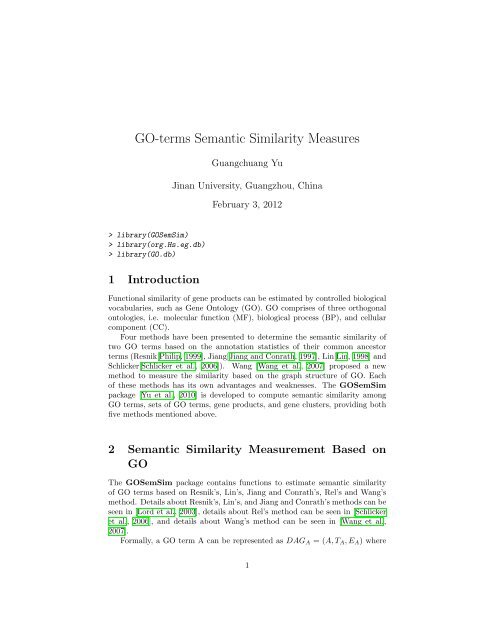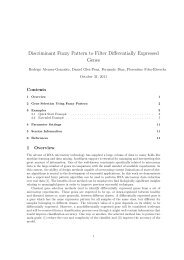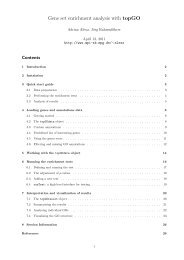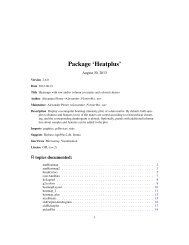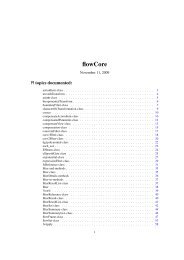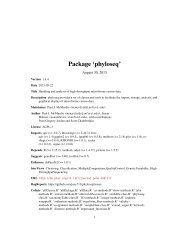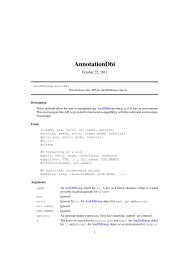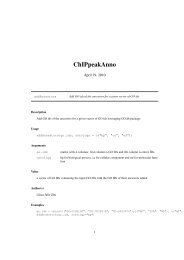GO-terms Semantic Similarity Measures
GO-terms Semantic Similarity Measures
GO-terms Semantic Similarity Measures
Create successful ePaper yourself
Turn your PDF publications into a flip-book with our unique Google optimized e-Paper software.
<strong>GO</strong>-<strong>terms</strong> <strong>Semantic</strong> <strong>Similarity</strong> <strong>Measures</strong><br />
Guangchuang Yu<br />
Jinan University, Guangzhou, China<br />
February 3, 2012<br />
> library(<strong>GO</strong>SemSim)<br />
> library(org.Hs.eg.db)<br />
> library(<strong>GO</strong>.db)<br />
1 Introduction<br />
Functional similarity of gene products can be estimated by controlled biological<br />
vocabularies, such as Gene Ontology (<strong>GO</strong>). <strong>GO</strong> comprises of three orthogonal<br />
ontologies, i.e. molecular function (MF), biological process (BP), and cellular<br />
component (CC).<br />
Four methods have been presented to determine the semantic similarity of<br />
two <strong>GO</strong> <strong>terms</strong> based on the annotation statistics of their common ancestor<br />
<strong>terms</strong> (Resnik[Philip, 1999], Jiang[Jiang and Conrath, 1997], Lin[Lin, 1998] and<br />
Schlicker[Schlicker et al., 2006]). Wang [Wang et al., 2007] proposed a new<br />
method to measure the similarity based on the graph structure of <strong>GO</strong>. Each<br />
of these methods has its own advantages and weaknesses. The <strong>GO</strong>SemSim<br />
package [Yu et al., 2010] is developed to compute semantic similarity among<br />
<strong>GO</strong> <strong>terms</strong>, sets of <strong>GO</strong> <strong>terms</strong>, gene products, and gene clusters, providing both<br />
five methods mentioned above.<br />
2 <strong>Semantic</strong> <strong>Similarity</strong> Measurement Based on<br />
<strong>GO</strong><br />
The <strong>GO</strong>SemSim package contains functions to estimate semantic similarity<br />
of <strong>GO</strong> <strong>terms</strong> based on Resnik’s, Lin’s, Jiang and Conrath’s, Rel’s and Wang’s<br />
method. Details about Resnik’s, Lin’s, and Jiang and Conrath’s methods can be<br />
seen in [Lord et al., 2003], details about Rel’s method can be seen in [Schlicker<br />
et al., 2006], and details about Wang’s method can be seen in [Wang et al.,<br />
2007].<br />
Formally, a <strong>GO</strong> term A can be represented as DAG A = (A, T A , E A ) where<br />
1
T A is the set of <strong>GO</strong> <strong>terms</strong> in DAG A , including term A and all of its ancestor<br />
<strong>terms</strong> in the <strong>GO</strong> graph, and E A is the set of edges connecting the <strong>GO</strong> <strong>terms</strong> in<br />
DAG A .<br />
To encode the semantics of a <strong>GO</strong> term in a measurable format to enable<br />
a quantitative comparison between two term’s semantics, we firstly define the<br />
semantic value of term A as the aggregate contribution of all <strong>terms</strong> in DAG A<br />
to the semantics of term A, <strong>terms</strong> closer to term A in DAG A contribute more<br />
to its semantics. Thus, define the contribution of a <strong>GO</strong> term t to the semantics<br />
of <strong>GO</strong> term A as the S-value of <strong>GO</strong> term t related to term A. For any of term<br />
t in DAG A = (A, T A , E A ), its S-value related to term A. S A (t) is defined as:<br />
{<br />
SA (A) = 1<br />
S A (t) = max{w e × S A (t ′ )|t ′ ∈ childrenof(t)} if t ≠ A<br />
where w e is the semantic contribution factor for edge e ∈ E A linking term t<br />
with its child term t’. We defined term A contributes to its own as one. After<br />
obtaining the S-values for all <strong>terms</strong> in DAG A , the semantic value of <strong>GO</strong> term<br />
A, SV(A), is calculated as:<br />
SV (A) = ∑<br />
t∈T A<br />
S A (t)<br />
Given two <strong>GO</strong> <strong>terms</strong> A and B, the semantic similarity between these two<br />
<strong>terms</strong>, <strong>GO</strong> A,B , is defined as:<br />
S <strong>GO</strong> (A, B) =<br />
∑<br />
t∈T A ∩T B<br />
S A (t) + S B (t)<br />
SV (A) + SV (B)<br />
where S A (t) is the S-value of <strong>GO</strong> term t related to term A and S B (t) is the<br />
S-value of <strong>GO</strong> term t related to term B.<br />
The method descriped above is proposed by Wang[Wang et al., 2007]. The<br />
Wang’s method determines the semantic similarity of two <strong>GO</strong> <strong>terms</strong> based on<br />
both the locations of these <strong>terms</strong> in the <strong>GO</strong> graph and their relations with their<br />
ancestor <strong>terms</strong>.<br />
The other four methods proposed by Resnik[Philip, 1999], Jiang[Jiang and<br />
Conrath, 1997], Lin[Lin, 1998] and Schlicker[Schlicker et al., 2006] are information<br />
content (IC) based, which depend on the frequencies of two <strong>GO</strong> <strong>terms</strong><br />
involved and that of their closest common ancestor term in a specific corpus<br />
of <strong>GO</strong> annotations. Information content is defined as frequency of each<br />
term occurs in the corpus. At present, <strong>GO</strong>SemSim supports analysis on<br />
many species. We used Bioconductor package org.At.tair.db, org.Ag.eg.db,<br />
org.Bt.eg.db, org.Cf.eg.db, org.Gg.eg.db, org.Pt.eg.db, org.Sco.eg.db, org.EcK12.eg.db,<br />
org.EcSakai.eg.db, org.Dm.eg.db, org.Hs.eg.db, org.Pf.plasmo.db, org.Mm.eg.db,<br />
org.Ss.eg.db, org.Rn.eg.db, org.Mmu.eg.db, org.Ce.eg.db, org.Xl.eg.db, org.Sc.sgd.db<br />
and org.Dr.eg.db to calculate the information content of Arabidopsis, Anopheles,<br />
Bovine, Canine, Chicken, Chimp, Coelicolor, E coli strain K12 and strain<br />
Sakai, Fly, Human, Malaria, Mouse, Pig, Rat, Rhesus, Worm, Xenopus, Yeast<br />
2
and Zebrafish respectively. The information content will update regularly.<br />
As <strong>GO</strong> allow multiple parents for each concept, two <strong>terms</strong> can share parents<br />
by multiple paths. We take the mininmum p(t), where there is more than on<br />
shared parents. The p ms is defined as:<br />
p ms (t1, t2) =<br />
min {p(t)})<br />
t∈S(t1,t2)<br />
Where S(t1,t2) is the set of parent <strong>terms</strong> shared by t1 and t2.<br />
similarity of Resnik’s method is defined as:<br />
The similarity of Lin’s is defined as:<br />
sim(t1, t2) = − ln p ms (t1, t2)<br />
sim(t1, t2) = 2 × ln(p ms(t1, t2))<br />
ln p(t1) + ln p(c2)<br />
The similarity of Schlicker’s method combine Resnik’s and Lin’s method is defined<br />
as:<br />
sim(t1, t2) = 2 × ln p ms(t1, t2)<br />
ln p(t1) + ln p(p2) × (1 − p ms(t1, t2))<br />
The Jiang and Conrath’s method define a semantic similarity as:<br />
where<br />
sim(t1, t2) = 1 − min(1, d(t1, t2))<br />
d(t1, t2) = ln p(t1) + ln p(p2) − 2 × ln p ms (t1, t2)<br />
In <strong>GO</strong>SemSim, on the basis of semantic similarity between <strong>GO</strong> <strong>terms</strong>, we can<br />
also compute semantic similarity among sets of <strong>GO</strong> <strong>terms</strong>, gene products, and<br />
gene clusters. We implemented four methods which called max, average,<br />
rcmax, and rcmax.avg to combine semantic similarity scores of multiple <strong>GO</strong><br />
<strong>terms</strong>. The similarities among gene products and gene clusters which annotated<br />
by multiple <strong>GO</strong> <strong>terms</strong> were also calculated by the same combine methods<br />
mentioned above.<br />
Given two <strong>GO</strong> <strong>terms</strong> sets <strong>GO</strong> 1 = {go 11 , go 12 · · · go 1m } and <strong>GO</strong> 2 = {go 21 , go 22 · · · go 2n },<br />
method max calculate the maximum semantic similarity score over all pairs of<br />
<strong>GO</strong> <strong>terms</strong> between these two sets, method average calcuate the average semantic<br />
similarity score over all pairs of <strong>GO</strong> <strong>terms</strong>.<br />
Similarities between <strong>GO</strong> <strong>terms</strong> form a matrix, and method rcmax use the<br />
maximum of RowScore and ColumnScore as the similarity, where RowScore (or<br />
ColumnScore) is the average of maximum similarities on each row (or column).<br />
And method rcmax.avg calculate the average of all maximum similarities on<br />
each row and column, and defined as:<br />
∑<br />
1≤i≤m<br />
Sim(<strong>GO</strong>1, <strong>GO</strong>2) =<br />
max(Sim((go 1i ), (<strong>GO</strong> 2 ))) +<br />
∑<br />
max(Sim((go 2j ), (<strong>GO</strong> 1 )))<br />
1≤j≤n<br />
m+n<br />
The<br />
3
3 Functions<br />
A Params stores a set of parameters for measuring semantic similarity. Params<br />
containing parameters are ontology, organism, method, combine, and drop-<br />
Codes. Parameter ontology specify which ontology were used in measurement,<br />
organism specifiy which <strong>GO</strong> Map were loaded for mapping Gene IDs to <strong>GO</strong><br />
<strong>terms</strong>, dropCodes restrict evident codes when mapping Gene IDs to <strong>GO</strong> Terms,<br />
method specify which method to be used to measure the similarity and combine<br />
sepcify which combine method was used to combining semantic similarity<br />
scores.<br />
> params go1 go2 gos gs1 gs2 gs x hsEG set.seed clusters geneClusters sim(gos,params)<br />
<strong>GO</strong>:0009055 <strong>GO</strong>:0020037<br />
<strong>GO</strong>:0004022 0.318 0.151<br />
<strong>GO</strong>:0004024 0.290 0.136<br />
<strong>GO</strong>:0004023 0.290 0.136<br />
> setCombineMethod(params) sim(gos,params)<br />
[1] 0.273<br />
> sim(gs, params)<br />
4
[1] "loading <strong>GO</strong>Map..."<br />
[1] "Done..."<br />
578 582 400 409 411<br />
835 0.736 1.000 0.471 0.726 0.576<br />
5261 0.591 0.842 0.527 0.606 0.376<br />
241 0.744 1.000 0.533 0.700 0.382<br />
994 0.467 0.647 0.377 0.555 0.665<br />
514 0.292 0.390 0.421 0.277 0.603<br />
533 0.382 0.481 0.354 0.359 0.406<br />
> sim(geneClusters, params)<br />
a b c<br />
a 1.000 0.762 0.736<br />
b 0.762 1.000 0.772<br />
c 0.736 0.772 1.000<br />
The old function calls which maybe more user friendly were also supported.<br />
They are wrapper functions of function sim mentioning above.<br />
> goSim("<strong>GO</strong>:0004022", "<strong>GO</strong>:0005515", ont="MF", measure="Wang")<br />
[1] 0.252<br />
> go1 = c("<strong>GO</strong>:0004022","<strong>GO</strong>:0004024","<strong>GO</strong>:0004174")<br />
> go2 = c("<strong>GO</strong>:0009055","<strong>GO</strong>:0005515")<br />
> mgoSim(go1, go2, ont="MF", measure="Wang", combine="rcmax.avg")<br />
[1] 0.299<br />
> geneSim("241", "251", ont="MF", organism="human", measure="Wang", combine="rcmax.avg")<br />
$geneSim<br />
[1] 0.368<br />
$<strong>GO</strong>1<br />
[1] "<strong>GO</strong>:0005515" "<strong>GO</strong>:0004051" "<strong>GO</strong>:0008047" "<strong>GO</strong>:0019899"<br />
[5] "<strong>GO</strong>:0042803" "<strong>GO</strong>:0046982" "<strong>GO</strong>:0047485" "<strong>GO</strong>:0050544"<br />
$<strong>GO</strong>2<br />
[1] "<strong>GO</strong>:0004035" "<strong>GO</strong>:0046872" "<strong>GO</strong>:0016787"<br />
> mgeneSim(genes=c("835", "5261","241", "994"), ont="MF", organism="human", measure="Wang")<br />
835 5261 241 994<br />
835 1.000 0.584 0.666 0.666<br />
5261 0.584 1.000 0.562 0.435<br />
241 0.666 0.562 1.000 0.466<br />
994 0.666 0.435 0.466 1.000<br />
5
clusterSim(gs1, gs2, ont="MF", organism="human", measure="Wang", combine="rcmax.avg")<br />
[1] 0.737<br />
> mclusterSim(clusters, ont="MF", organism="human", measure="Wang", combine="rcmax.avg")<br />
a b c<br />
a 1.000 0.762 0.736<br />
b 0.762 1.000 0.772<br />
c 0.736 0.772 1.000<br />
Session Information<br />
The version number of R and packages loaded for generating the vignette were:<br />
R version 2.14.1 (2011-12-22)<br />
Platform: x86_64-unknown-linux-gnu (64-bit)<br />
locale:<br />
[1] LC_CTYPE=en_US.UTF-8 LC_NUMERIC=C<br />
[3] LC_TIME=en_US.UTF-8 LC_COLLATE=C<br />
[5] LC_MONETARY=en_US.UTF-8 LC_MESSAGES=en_US.UTF-8<br />
[7] LC_PAPER=C LC_NAME=C<br />
[9] LC_ADDRESS=C LC_TELEPHONE=C<br />
[11] LC_MEASUREMENT=en_US.UTF-8 LC_IDENTIFICATION=C<br />
attached base packages:<br />
[1] stats graphics grDevices utils datasets<br />
[6] methods base<br />
other attached packages:<br />
[1] <strong>GO</strong>.db_2.6.1 org.Hs.eg.db_2.6.4<br />
[3] <strong>GO</strong>SemSim_1.12.1 AnnotationDbi_1.16.11<br />
[5] Biobase_2.14.0 DOSE_1.0.0<br />
[7] RSQLite_0.11.1 DBI_0.2-5<br />
loaded via a namespace (and not attached):<br />
[1] DO.db_2.3.0 IRanges_1.12.5<br />
[3] org.Ag.eg.db_2.6.4 org.At.tair.db_2.6.4<br />
[5] org.Bt.eg.db_2.6.4 org.Ce.eg.db_2.6.4<br />
[7] org.Cf.eg.db_2.6.4 org.Dm.eg.db_2.6.4<br />
[9] org.Dr.eg.db_2.6.4 org.EcK12.eg.db_2.6.4<br />
[11] org.EcSakai.eg.db_2.6.4 org.Gg.eg.db_2.6.4<br />
[13] org.Mm.eg.db_2.6.4 org.Mmu.eg.db_2.6.4<br />
[15] org.Pf.plasmo.db_2.6.4 org.Pt.eg.db_2.6.4<br />
[17] org.Rn.eg.db_2.6.4 org.Sc.sgd.db_2.6.4<br />
6
[19] org.Sco.eg.db_2.4.2 org.Ss.eg.db_2.6.4<br />
[21] org.Xl.eg.db_2.6.4 plyr_1.7.1<br />
[23] qvalue_1.28.0 tcltk_2.14.1<br />
[25] tools_2.14.1<br />
References<br />
Jay J. Jiang and David W. Conrath. <strong>Semantic</strong> similarity based on corpus statistics<br />
and lexical taxonomy. Proceedings of 10th International Conference on<br />
Research In Computational Linguistics, 1997. URL http://www.citebase.<br />
org/abstract?id=oai:arXiv.org:cmp-lg/9709008.<br />
Dekang Lin. An Information-Theoretic definition of similarity. In Proceedings<br />
of the 15th International Conference on Machine Learning, pages 296—304,<br />
1998. doi: 10.1.1.55.1832. URL http://citeseerx.ist.psu.edu/viewdoc/<br />
summary?doi=10.1.1.55.1832.<br />
P W Lord, R D Stevens, A Brass, and C A Goble. <strong>Semantic</strong> similarity measures<br />
as tools for exploring the gene ontology. Pacific Symposium on Biocomputing.<br />
Pacific Symposium on Biocomputing, pages 601–12, 2003. ISSN 1793-5091.<br />
doi: 12603061. URL http://www.ncbi.nlm.nih.gov/pubmed/12603061.<br />
PMID: 12603061.<br />
Resnik Philip. <strong>Semantic</strong> similarity in a taxonomy: An Information-<br />
Based measure and its application to problems of ambiguity in natural<br />
language. Journal of Artificial Intelligence Research, 11:95–<br />
130, 1999. URL http://nzdl.sadl.uleth.ca/cgi-bin/library?e=<br />
d-00000-00---off-0jair--00-0--0-10-0---0---0prompt-10---4-------0-1l--11-en-50---20-ab<br />
CL3.1.11&d=jair-514&x=1.<br />
Andreas Schlicker, Francisco S Domingues, JÃűrg RahnenfÃijhrer, and Thomas<br />
Lengauer. A new measure for functional similarity of gene products based on<br />
gene ontology. BMC Bioinformatics, 7:302, 2006. ISSN 1471-2105. doi:<br />
1471-2105-7-302. PMID: 16776819.<br />
James Z Wang, Zhidian Du, Rapeeporn Payattakool, Philip S Yu, and Chin-Fu<br />
Chen. A new method to measure the semantic similarity of go <strong>terms</strong>. Bioinformatics<br />
(Oxford, England), 23:1274–81, May 2007. ISSN 1460-2059. doi:<br />
btm087. URL http://www.ncbi.nlm.nih.gov/pubmed/17344234. PMID:<br />
17344234.<br />
Guangchuang Yu, Fei Li, Yide Qin, Xiaochen Bo, Yibo Wu, and Shengqi<br />
Wang. Gosemsim: an r package for measuring semantic similarity among<br />
go <strong>terms</strong> and gene products. Bioinformatics, 26:976–978, 2010. ISSN 1367-<br />
4803. doi: 10.1093/bioinformatics/btq064. URL http://bioinformatics.<br />
oxfordjournals.org/cgi/content/abstract/26/7/976. PMID: 20179076.<br />
7


